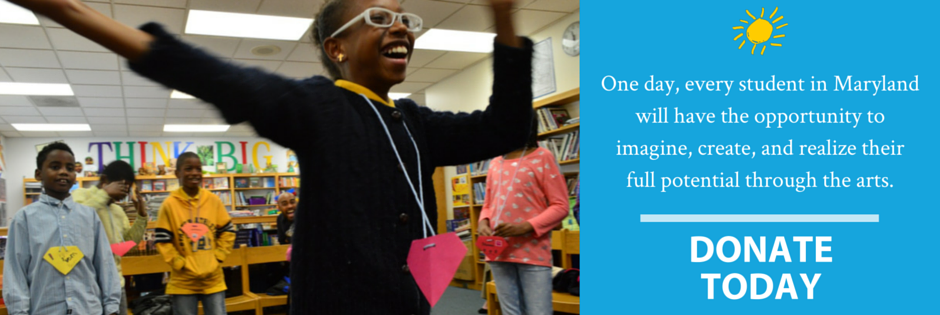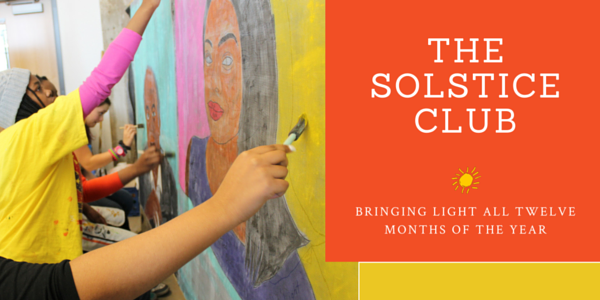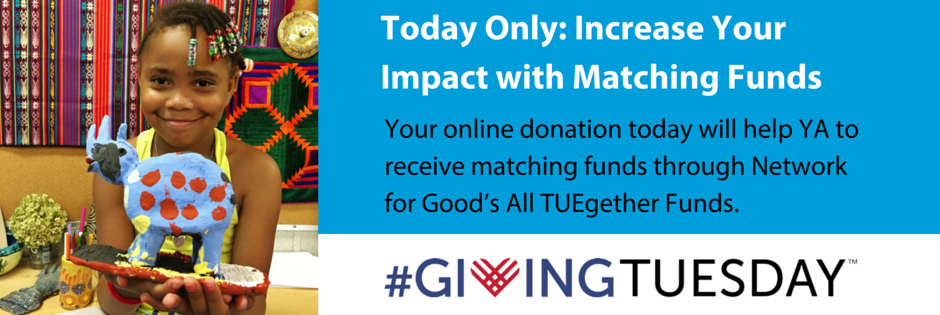Blog
Measuring Joy

by Stacie Sanders Evans, Young Audiences/Arts for Learning Executive Director
I was reminded of my friend Deborah Bedwell, the former executive director of Baltimore Clayworks, this week when I visited my daughter Virginia’s classroom to observe a workshop led by Tori Bertocci of Synetic Theater. Deborah wrote an article back in 2001 called “Measuring Joy,” which detailed her journey of trying to arrive at measurable outcomes in her work while remaining true to the spirit of her organization or, as Deb put it, “not lying” to the funders who were increasingly asking to quantify the impact of Baltimore Clayworks on humanity. Deb decided the best course of action was to come up with a way to measure the joy created by touching clay. I was new to Maryland and to Young Audiences when I came across this article.
“How rebellious!” I thought and I went on my way and on my own journey of trying to establish a connection between our work and academic outcomes. Deb’s evaluation tool and the article that accompanied it, has stuck with me for more than a decade—through No Child Left Behind, the adoption of the Common Core and new standardized assessments and teacher evaluations. When it came time to select a school for my own child, I ignored test results and walked through many school hallways and sat in many classrooms…simply looking for joy.
The second graders at Virginia’s school are currently studying fairytales so we thought it would be a good time to bring in the Washington, D.C.-based group Synetic Theater for a classroom workshop. Synetic Theater specializes in physical theater, blending elements of gymnastics, dance, improvisation, mime, and acting. Through teaching the four elements—body, emotion, focus, and imagination—they brought different interpretations of the classic fairytale “Cinderella” to life.

“They are SO happy!” Virginia’s teacher said to me. “Even the kids who aren’t happy are happy.” I looked at my daughter’s amazing teacher, and while she is always happy, and beloved by her students and their parents, she was especially happy that morning relishing the joy she saw on her students’ faces. At that moment I wished I had Deb’s observation tool with me because the joy in that classroom was off the charts.
While I believe, and research shows, that the arts positively impact student achievement, I understand that part of the secret sauce of learning in or through the arts is the simple joy that it creates. The joy these students experience give teachers and parents that same feeling of joy when witnessing this act, and this in turn creates a joyful learning environment. It is in this environment that kids and adults alike are more likely to look beyond any constraints and envision—and act on—something better for themselves and each other.

Richard Deasy, the founding director of Arts Education Partnership, has told me many times, “You can’t make a learner learn. It is the decision of the learner.” What Young Audiences teaching artists and teacher partners do is offer approaches in which the student wants to learn. We saw that in Virginia’s class of 26 students who were opting into learning at that moment because of the joy derived from physical theater.
Let’s imagine something better for our children in public education –something better but something also very basic — joyful learning environments — where kids, parents, and teachers are eager to engage. YA aims to do this every year through its mission. Won’t you join us in the cause?
New Professional Development Workshops for Artists
The Teaching Artist Institute (TAI) has developed two new three-hour professional development workshops designed for both new and established artists and teaching artists.
The winter 2016 workshop will be led by TAI Co-facilitator (TAICO) Laura Zam and focuses on helping teaching artists navigate the Common Core. The spring 2016 workshop, led TAI Co-facilitator (TAICO) Valerie Branch, will give artists the tools to keep art in the classroom by improving teacher-student relationships and classroom management.

February 10: Making the Common Core Friendly, Meaningful and Fun
At the heart of a teaching artist’s practice is a personal relationship to the art itself. And yet, this often feels compromised as they conform to schools, standards, and testing. Can school-based work be more artistically satisfying—not just for students, but for the teaching artist? On February 10, 2016, TAI Co-facilitator Laura Zam aims to answer this question during Making the Common Core Friendly, Meaningful and Fun, a workshop designed for new and established teaching artists. Laura will break down the Common Core—making it much easier to master—and help teaching artists connect this content to the deepest levels of their artistry.

May 16: Classroom 101: Breaking Down Your Art Form
On May 16, 2016, TAI Co-facilitator Valerie Branch will guide artists through the elements within their respective art form and demonstrate how art can improve classroom management and teacher-to-student relationships. In Classroom 101: Breaking Down Your Art Form, artist participants will learn how to break down their art form into simple, yet powerful strategies that allow the flexibility to work with students and teachers of varying abilities. Artists will leave with the tools for keeping art in the classroom—and have their teacher-partners embrace it!
– – – – – – – – – – – – – – – – – – – – – – – – – – – – – – – – – – – – – – – – – –
Both workshops are limited to 20 participants. The cost to attend each workshop is $25 for non-YA artists and free for YA roster artists. Tickets are available on a first-come, first-served basis. Registration is required.
Get Tickets:
Making the Common Core Friendly, Meaningful and Fun
When: Wednesday, February 10, 2016 from 12:00 PM to 3:00 PM
Where: The Dream House – 1430 Carswell St, Baltimore, MD 21218
Classroom 101: Breaking Down Your Art Form
When: Monday, May 16, 2016 from 12:00 PM to 3:00 PM
Where: The Dream House – 1430 Carswell St, Baltimore, MD 21218
New Arts Integration Pilot Program
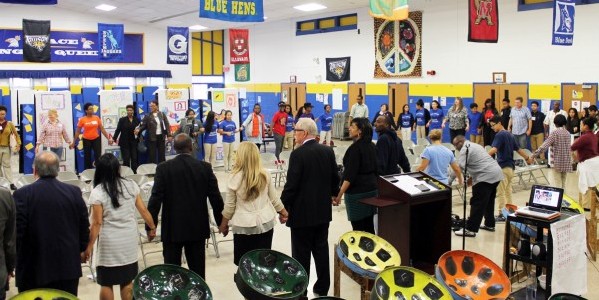
By JOHNATHON CLINKSCALES, Originally published on www.somdnews.com
In an effort to expand teaching opportunities and transform the lives of all students through the arts, Young Audiences/Arts for Learning of Maryland and Prince George’s County Public Schools celebrated the launch of a new arts integration partnership on Nov. 17 during a kick-off performance at Oxon Hill Middle School in Fort Washington.
“The arts represent the ability to teach children, help children be imaginative, innovative [and] creative and I think we need that,” PGCPS Chief Executive Officer Kevin Maxwell said. “[It’s about] engaging the whole child and having kids able to do more than just left brain functions of memorizing and computing, [which is really important in bringing out their] creative and innovative sides.”
John Ceschini, an arts integration officer for PGCPS, said the arts integration pilot program is currently offered at 41 schools in the county. Oxon Hill Middle was chosen because it reinforces education in a different way by integrating arts with the science, technology, engineering and mathematics disciplines.
“Oxon Hill [Middle] is STEAM school, which is STEM across the arts,” he said. “They do a lot with the integration of science, technology, engineering and math with the arts.”
For Ceschini, he supports the research related to student participation and academic achievement.
“There’s a lot of research that says that the arts impact learning, improves student retention and also increases student engagement,” he said. “So why wouldn’t we bring something like that [which] can contribute to student achievement.”
As the nation’s largest arts-in-education network commemorating 65 years of service, Young Audiences of Maryland ensures all students are given the best circumstances for learning by working in partnership with schools and school districts to provide arts integration professional development for educators, according to the YA website.
“We envisioned a day in Prince George’s County where every student has the opportunity to imagine, to create and to realize their full potential through the arts,” said YA Executive Director Stacie Evans. “We believe that artists can be catalysts in our schools. Through their art form, they can develop new approaches to teaching the curriculum. They inspire children and they help reach some of our struggling learners. It’s because the arts and the self-expression and the creativity required of the arts brings meaning to learning.”
YA’s Chief Innovation Officer and Education Director Pat Cruz said she is impressed with the work that PGCPS had done to restore arts education in the classroom.
“It is an honor to serve such dedicated and hard working educators who, despite all the challenges they have, are truly going above and beyond to provide their students with the best learning experience as possible,” she said. “We’ve tried to support that work in four ways in Prince George’s County. First, it’s … by providing quality cultural arts programs that are connected to the curriculum and provide grant writing assistance to bring them into the schools. … Second, we’re working with John Ceschini’s office to provide professional development and expertise to the new arts integration schools. … Third, in partnership with New York City’s American Place Theatre, we’re proud to present the Literature to Life theatre experience … to discuss issues of society such as racism and inequality.”
As a result of YA’s efforts, Evans said more PGCPS students have benefited from the arts integration program.
“Young Audience’s mission is to transform the lives and education of youth through the arts,” she said. “We’re very committed to reaching out to children across the state and in fact, we’ve reached children in every single county and impacted the education of 182,000 students.”
Evans also said YA will expand its outreach thanks to Maxwell’s dedication to the arts.
“This year, we’re going to increase our reach by nearly 5,000 students [compared to] the year before,” Evans said. “It’s really because Dr. Maxwell is committed to the arts and he’s creating opportunities for us to try and integrate the arts across the curriculum.”
For Oxon Hill Middle School Principal Wendell Coleman, the arts integration program promotes the school’s motto of PEACE — positive energy activates constant elevation.
“The partnership with Young Audiences has been a critical opportunity for our kings and queens,” Coleman said. “Arts integration is a big part of our school … [and exposes them] to the beauty of the arts and what it can mean for them for a lifetime. … It’s so fulfilling to come to work every single day with [a] great dedicated group of educators. Nothing happens without solid teaching, nothing. We value our teachers as much as possible.”
Originally published on www.somdnews.com
Support Young Audiences on This #GivingTuesday
Do you have a favorite childhood arts experience? Do you believe the arts should be a part of every child’s education?
Consider #GivingTuesday as an opportunity to support Young Audiences/Arts for Learning as a way to provide thousands of Maryland students—from Pre-K to 12th Grade—with inspiring, engaging, and transformational arts experiences.
Young Audiences’ roster of more than 100 professional teaching artists provides thousands of arts learning experiences to more than 450 schools and community organizations in every corner of Maryland, reaching over 180,000 students.
Support Young Audiences of Maryland with your tax-deductible donation.
Your support of Young Audiences ensures that we can:
- Bring the arts into schools all year long by partnering with dozens of professional artists who live in our very own communities, whether they are musicians, dancers, actors, playwrights, poets, or potters, and giving them the opportunity to do what they do best—perform, create, and inspire.
- Reach schools in rural counties and urban areas, and schools that serve students with special needs by creating access to the arts and lowering financial barriers.
- Train artists by helping them understand how to use their art as a tool to teach children of all abilities and how to work in different settings—from preschool to high school, in school or after-school.
- Train teachers of all subject areas to use the arts as a way to engage students in the learning process and reach different kinds of learners with proven arts integration techniques.
Learn more>> What Your Gift Supports
Consider Joining the Solstice Club
Join the Solstice Club as a Monthly Donor
Through monthly donations, the Solstice Club provides Young Audiences with a consistent and reliable source of funding that allows us to plan ahead—bringing light all twelve months of the year.
When you join the Solstice Club, you will join a special group of people who provide a monthly donation—of $10 or more—to support arts programs for students and professional development for teachers.
A Teacher’s Story
by Tracey Cooper, Science Teacher at Oxon Hill Middle School and Site Director of Young Audiences’ Summer Arts Academy
I am a wife, mother, and educator. I have spent the past 14 years in Baltimore City as a science teacher, department head, and district coordinator for summer programs.
When I graduated from Towson University, I wanted to leave my mark and change the world. I wanted to instill a love for science and learning. I thought I had everything I needed – plus an amazing collection of professional attire! Reality, however, did not get the memo. That first year was a bust!
I followed the lessons in the book, but most students were not engaged. I gave up my *beloved* summer vacation to teach science in summer school, hoping to learn alternative ways to deliver the lessons. That first summer, I had 20 students on my roster and a binder full of stock lessons. Only 9 students attended. Only 4 of those 9 passed. Another bust.
Over the years, I improved my lessons and grew in my profession. Student achievement increased, but I wanted more. Eventually, I became a coordinator for summer programs at Baltimore City Schools. And the year I met and collaborated with Young Audiences of Maryland, I fell in love.
Over the next few of summers, I worked with Young Audiences revising the way we did things in summer school. Artists were more actively involved in the content classes and were not just providing enrichment for students. We initiated a co-teaching model between artists and the STEM (Science, Technology, Engineering, and Math) instructors.

Attendance soared. The attendance rate was the highest we had seen over the past three summers. Students who were enrolled in the arts-integrated lessons did better on their math and science tests. I finally saw that education could be fun and creative for both students and teachers. Artists and teachers maximized their professional abilities through collaboration and support, creating a rich tableau of experiences for students.
This past summer, Baltimore City Schools asked Young Audiences to develop a more comprehensive summer learning program. Although I had different plans for my summer, how could I pass on the opportunity to work as a site director with Young Audiences of Maryland?
The result? The Summer Arts Academy: a fully arts-integrated summer learning program that provided a dynamic, creative, and supportive environment for students to learn about the creative process and grow socially, emotionally, and academically.

Teachers received dynamic training from the Maryland State Department of Education and planned integrated lessons with engaging strategies that included movement, rap, and improv! Each week, teachers reflected on their work with the teaching artists, modifying, as needed, both teaching practice and student process. Other summer learning sites had discipline issues, but our students were too busy learning and having fun.
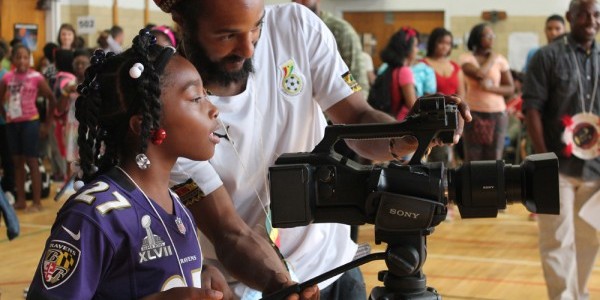
This experience has inspired not only students but also teachers. As an educator, I see a new way to instruct our children and make an impact. I now use the arts integration techniques I learned over the summer to encourage and empower students and teachers. Young Audiences’ comprehensive approach to arts integration maximizes the learning process for educators. With the help of Young Audiences, students may have found a love of learning, but I have been renewed in the art of teaching. Reality seems to have finally gotten the memo!
YA Forges New Arts Integration Partnership

A teacher from Oxon Hill Middle School personally thanked Young Audiences during a post-event gathering for bringing the Literature to Life program to Prince George’s schools. After a performance of “Black Boy,” a verbatim adaptation and stage performance of the classic American literary work by Richard Wright, he said he saw one of his students carrying around the Richard Wright book. When he asked the student about it, the student said he decided to read it after seeing the performance. The teacher noted that he didn’t read that book until college and said, “This is what Young Audiences does for our students.”
On November 17, Young Audiences of Maryland and Dr. Kevin Maxwell, CEO of Prince George’s County Public Schools (PGCPS), announced the launch of a new arts integration partnership at a press conference held at Oxon Hill Middle School.
This new initiative will benefit more than 15,000 Prince George’s County Public School students in the 2015-2016 school year and dramatically increase student student access to the arts.
Dozens of teachers, principals, and PTA members were in attendance, along with school board members and PGCPS district office personnel. The event attracted the attention of local media outlets, including WUSA, a CBS news affiliate station in Washington, D.C., who ran a segment on the new partnership during their morning news coverage on November 17.

In the true spirit of Young Audiences, this was not your typical “black-tie” press conference. The room was filled with music, dance, laughter, and inspiring stories. Student performances from Oxon Hill Middle School’s Performing Arts Academy opened the event, showcasing the talents of the school’s students through music and dance performances. Young Audiences’ teaching artist Ssuuna engaged the audience in an interactive, call-and-response performance of music from his native Uganda with authentic African instruments.

With media cameras rolling, Dr. Maxwell spoke passionately about the importance of partnering with Young Audiences to bring high-quality arts programs to more PGCPS students. Integrating the arts into classrooms is not only critical to increasing student achievement and engagement; it is an essential component of every student’s education and maximizes the talents of all students. Dr. Maxwell’s belief in the importance of the arts-in-education—and the exceptional teaching artists and arts-in-education programs that Young Audiences provides—will ensure that all students have the opportunity to experience this critical part of their education.
Stacie Evans, Young Audiences’ Executive Director, echoed Dr. Maxwell’s remarks, saying:
We believe that artists are catalysts in our schools. Through their art form they develop new approaches to teaching the curriculum. They inspire children. They help reach the most reluctant and struggling learners. From the beginning, Dr. Maxwell made it clear that the arts are a priority and he welcomed community partners to be part of the solution to ensure that our kids receive a complete education. As a result, 15,000 more students are benefiting from Young Audiences programs this school year alone.
Additional speakers included Mr. Wendell Coleman, Oxon Hill Middle School Principal; John Ceschini, Arts Integration Officer for PGCPS; and Tracey Cooper, Oxon Hill Middle School science teacher.
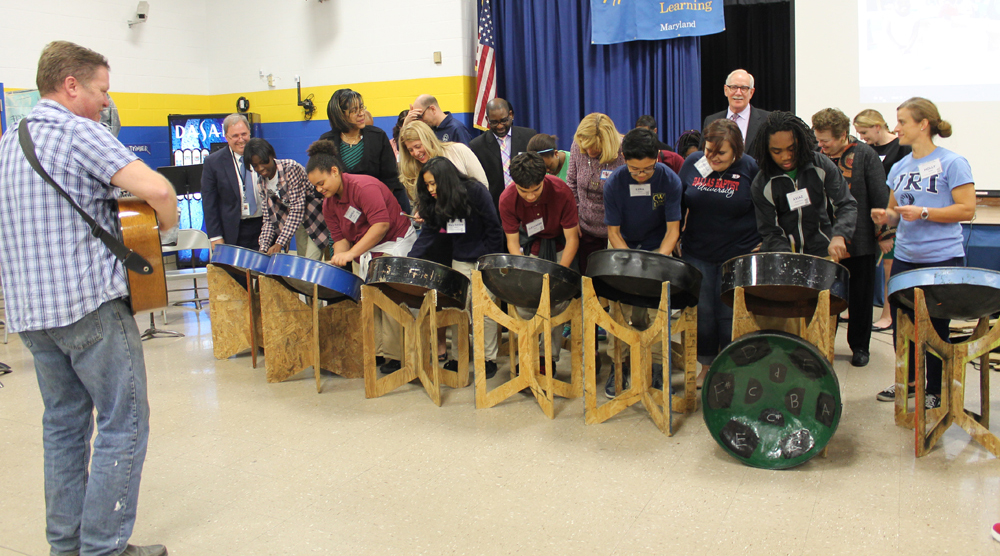
Young Audiences’ teaching artist Kevin Martin closed out the event with a steel drum ensemble of Oxon Hill Middle School students. These students—who jumped on stage to perform just hours after learning to play the steel drums—soon became the teachers. The steel drum performance culminated with Kevin inviting audience members, including Dr. Maxwell, to join a student at their drum and follow the student’s lead in learning the song.
A teacher from Oxon Hill Middle School personally thanked Young Audiences during a post-event gathering for bringing the Literature to Life program to Prince George’s schools. After a performance of “Black Boy,” a verbatim adaptation and stage performance of the classic American literary work by Richard Wright, he said he saw one of his students carrying around the Richard Wright book. When he asked the student about it, the student said he decided to read it after seeing the performance. The teacher noted that he didn’t read that book until college and said, “This is what Young Audiences does for our students.”

From theatrical productions that bring American literary masterpieces to life, to artist residencies for kindergarten students that inspire environmental citizenship, this new partnership with Prince George’s County Schools significantly increases access to arts learning for thousands of PGCPS students and leverages the talent of 20 teaching artists, the resources of six private and public funders, and advances the goals of PGCPS and YA to transform the lives and education of all students through the arts.
Research shows a direct connection between participation in the arts and student achievement. Research also shows having the arts in schools contributes to positive school culture and builds the creative and critical thinking skills that our workforce needs. Despite these benefits, student access to the arts as part of their education has declined. Young Audiences is honored to partner with Dr. Kevin Maxwell, named a Champion of Change by President Obama for his dedication to the arts, because he is committed to ensuring that PGPCS students are not denied the arts as part of a complete education.
Powering Arts Integration with Innovative Programming
Young Audiences’ programming for PGCPS will combine arts learning with traditional subjects such as science, math, and reading, expand in-school opportunities for professional teaching artists, and include further arts integration advancement through strengthening teacher preparation and professional development. Program areas to include:
GROWING UP GREEN
A Kindergarten-level environmental literacy program that supports a thematic approach and addresses the Maryland Environmental Literacy Curriculum Standards. Curriculum will be developed collaboratively among partner organizations and, following a successful pilot of the program, will later be infused into the kindergarten science and social studies core content areas. Financial support provided by BGE, Chesapeake Bay Trust and Maryland State Arts Council Artist in Residence Program.
LITERATURE TO LIFE
Through our unique combination of interactive theater, literature, and education, Literature to Life brings American literary masterpieces to life —giving voice to words and inspiring young people to find their own voice. Financial support provided by Laura Handman and Harold Ickes, Lisa and Porter Dawson, and other generous supporters.
PROFESSIONAL DEVELOPMENT
A series of professional development workshops designed for schools in their first year of joining the “Arts Integration” initiative. Educators will define and discuss the benefits of arts integrated teaching. After experiencing a sample drama and language arts lesson, teachers will brainstorm and apply creative challenges in their specific curriculum area. Program facilitated by Teaching Artist Institute.

Welcome to the Summer Arts Academy 2015!

Young Audiences has again partnered with Baltimore City Public Schools to make sure that arts-integrated learning does not end with the school year. On Monday, June 29, energy filled the gymnasium of Thomas Jefferson Elementary/Middle School as Young Audiences artists greeted 250 Baltimore City students and their families with high-energy performances, live music, and vibrant interactive art demonstrations during the kick-off assembly of the Summer Arts Academy.
The Academy is a five-week, city-wide program that provides students, third-grade through seventh-grade, with a free once-in-a-lifetime opportunity to spend their summer learning from the talented artists who live in our communities. The Academy was created as part of City Schools CEO Dr. Gregory Thornton’s plan to increase arts education opportunities for Baltimore City students. The Academy’s literacy component, with the overarching theme of “What Makes a Hero?” will be team-taught through the arts by City Schools teachers and faculty artists specializing in visual art, sound production, clay, African Drumming, modern and African dance, and improvisational and urban theatre. The Academy also gives students the opportunity discover art forms they have never experienced before and delve into two artistic disciplines of their choice. Students will perform at Artscape and visit other arts destinations through field trips. See the full list of the Academy’s artist faculty here!: Summer Academy Artists

See more photos from the Summer Arts Academy kick-off assembly here!
Hip Hop musician Jamaal “Mr. Root” Collier set the stage for the crowd during the Academy’s kick-off assembly. Joined by another Young Audiences musician, Kevin Gift, on the turntables, the performance used high-energy beats, improvised rapping, and beatboxing to get the crowd swaying and dancing. A couple of shy boys watched from afar, but slowly began to inch their way toward the booming set with growing curiosity.
Nearby, the dance moves of Cynthia Chavez of Baltimore Dance Crews Project (BDCP), caught the eye of three girls who were interested in learning how to moonwalk. Cynthia worked through foot techniques and demonstrations until the girls were ready to try it themselves.
Filmmaker and photographer Ras Tre showed one intrigued student how he operates his professional video camera equipment.

Artists, students, and family members began to gather on the dance floor as the popular music began to flow out of the speakers. One talented student stepped toward the center of the floor with confidence. He began to lead the choreography of one popular song while the crowd stepped back, learned the moves, and cheered him on. This encouraged other nearby students and artists to join in until the entire dance floor was full.
The assembly wrapped up with artists, teacher partners, and other Academy staff introducing themselves by dancing onto the stage. As students broke off into their grade-level groups, one parent asked: “Is there an adult Young Audiences class that the parents can take? We want to have this much fun, too!”
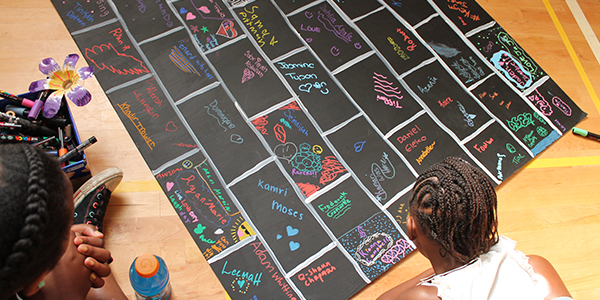
On average, all children can lose approximately two months of learning from the previous school year during the summer months without engaging education activities, and for low-income students, the loss is even greater. More than half of the achievement gap between low-income students and their more affluent peers can be attributed to the unequal access to summer learning opportunities. Programs like the Summer Arts Academy provide students with a safe place to go during the day, access to free healthy meals, adequate adult supervision, and positive, educational activities.
The high-energy kick-off assembly was only the beginning of what is to be expected this summer. Be sure to follow the Young Audiences blog, as well as our Facebook page, for updates from the Summer Arts Academy throughout July.
Creative Movement: Movimiento Creativo
By Valerie Branch, Young Audiences and Maryland Wolf Trap teaching artist
Empowering youth through my art form is something that I’m very passionate about. As a dance teaching artist, my role in the classroom is to enhance students’ development in decision-making, communication, and self-confidence through individual and shared movement explorations and experiences. Students learn how to control their impulses and self-manage when it is time to be silly and when it is time to stop and focus.
I recently completed a year-long Maryland Wolf Trap residency at Holabird Academy with teacher partner Ms. Katie Fincke and her pre-kindergarten class of students ages three to six. Our residency specialized in Language Arts with a focus on narratives and storytelling, so Ms. Fincke and I found ways to integrate movement experiences into the curriculum.
We accomplished our major teaching goal by using the elements of dance to help children convey meaning. We did this through a series of six different books that Ms. Fincke read with her students throughout the year. Ms. Fincke and I guided the children through the process of generating imaginative ideas about how to portray and connect to moments in the story through movement. Ms. Fincke’s class had many students whose first language was not English, so our goals uniquely overlapped with language development and vocabulary enhancement.

Ms. Fincke and I wanted the children to define and understand the meaning of creative movement. Our dancing activities did not follow the typical routine of me modeling a movement and students mimicking me. It was more about finding a way for me, Ms. Fincke, and the students, to have the experience together. Ms. Fincke and I didn’t want to robotically lead the children by saying, “Arm up, arm up, down, turn, turn!” Instead, it was the children leading us. We would hear, “No, let’s do our arms like this!” or “Let’s move like this! Let’s go here!” Students were given the chance to be creative and collaborate with their teachers and their peers. They were empowered to speak up and share their ideas because dance has no wrong answers. We encouraged our students to improvise without fear because we wanted them to know that their thoughts and ideas were valued. It’s a scary thing to express yourself with your body in front of a crowd. We wanted them to find a comfort level that would allow them to express themselves without limitations.
When I first walked into Holabird Academy, many of the students struggled with understanding personal space, body impulses, and self-confidence in creating and sharing ideas. Ms. Fincke and I have seen so many students flourish during the course of our partnership, but one student who made tremendous strides in social development and leadership was Oscar. We have watched Oscar become a leader and set a great example for his peers. He was never afraid to demonstrate his ideas through dance. He encouraged his peers to make strong independent choices. His classmates have been able to take risks and explore their creativity because they saw Oscar doing just that. Oscar demonstrated his leadership through an activity called the “mirror game,” which required students to slow down their energy and express themselves through dance in a calm and channeling way.

During the mirror game, one student at a time would face the class from the front of the room and then create slow movements with their body. The goal was to get the rest of the class to slowly repeat the leader’s movements as if they were the reflection in a mirror. Oscar really took interest in this activity and whenever he was up at the front of the room, he made sure that his movements were clear for his classmates to follow. Because he took the activity so seriously, there were times when other students would poke fun at him, but he didn’t let it bother him. A great leader is not somebody that forces their own ideas on people, but explores how people can share ideas together. Oscar led this activity with the intention to work with everyone as a team and that trait was very admirable.
What I loved most about working with this group was that I was not only able to teach them, but they were always teaching me. During the first few sessions, we would sing a greeting song in English, but by the third class, I had introduced the song in Spanish, a language I knew most of Ms. Fincke’s class was familiar with. Suddenly, the looks on their faces changed and they realized they knew the words. The kids lit up with excitement when they felt that sense of home and comfort in the classroom. Ms. Fincke and I always took time for the Spanish language and that was important to her students. It was also crucial for Ms. Fincke to take time to do translations and have the kids work together through their language differences.
It was important that we did not tell them to always speak English. Yes, we were in an environment where English was the primary language, but we also wanted them to hold strong to their heritage. Seeing them take ownership of their language was inspiring. We often let them sing and dance in Spanish and those were truly their moments to shine and demonstrate how far they were excelling in the knowledge and understanding of the skills we were sharing with them.
It’s been amazing to watch these students grow, interact with one another, and also feel better about themselves. It’s important to get them thinking about these things at an earlier age because I think that we often forget that children can have problems and stresses, too. We think that they don’t have any issues because they’re young, but our youth go through so much. They are witnesses to everything. They may be young, but they are just as much a part of our world as we are. Using dance and movement to build our youth into better citizens is something that empowers me as an artist.
Learn more about Valerie Branch and her dance programs for schools.
Create easy, DIY books

In our June smART Tip, Young Audiences Chief Innovation Officer Pat Cruz shows you how to make a book out of one piece of 8.5×11″ paper. Press play to get started and learn how this arts enrichment exercise can be used in any classroom!
smART Tips is a monthly video series sharing tips for educators who are interested in new, creative ways to use the arts in their classroom with students. See all smART Tips to date here. Interested in a specific topic? Let us know!
Communicate ideas through tableau

Our May smART Tip comes from Young Audiences Arts Integration Specialist Kristina Berdan. Press play to learn how you can easily incorporate theatre into your classroom by challenging students to communicate main ideas and supporting story details through tableau.
smART Tips is a monthly video series sharing tips for educators who are interested in new, creative ways to use the arts in their classroom with students. See all smART Tips to date here. Interested in a specific topic? Let us know!
Sing it loud!
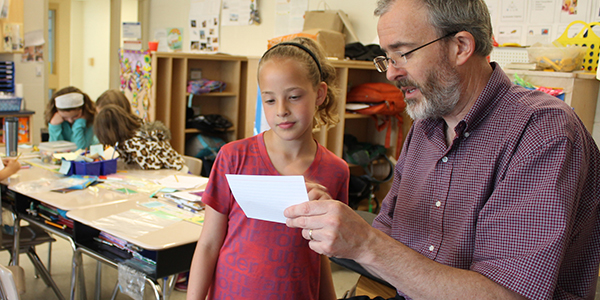
By Alden Phelps, Young Audiences artist and musician
My work as a teaching artist focuses on collaborative songwriting with children. The goal of my recent residency at Triadelphia Ridge Elementary School was to teach seven different classes of third and fourth graders how to create parodies of current pop songs that show their knowledge of science and history.
Teaching musical parodies is a great way for students to learn because it’s an opportunity to share their knowledge in a creative way. Students synthesize their knowledge of specific subjects with poetry in a song. There are several layers of learning going on, including using their knowledge of the curriculum, organizing ideas, and employing multiple Language Arts skills.
I worked directly with Triadelphia’s teachers to strategize how to address their needs through music by discussing their most recent units and the related curriculum standards. My customized arts-integrated residency addressed what the teachers wanted to focus on, namely a third grade unit on earth science and a fourth grade unit on Maryland history. The goal is always to reinforce what students have already learned through this new artistic skill.
The advantage to using current pop songs such as “Shake it Off” or “All About that Bass” is that the kids recognize the tunes immediately. I do background work to make sure all the songs will work in this unique collaborative project. Students always express an immense level of enthusiasm whenever I walk in with a list of handpicked songs they could use for their parody. For example, Mrs. Russell’s third grade class chose the hit “Call Me Maybe” by Carly Rae Jepson for their parody about weather patterns. In the end, their song was titled “Save My Granny,” and it describes several different extreme weather patterns in a clever and funny way.
I began by teaching the children basic elements to songwriting and composing. We did this by counting the number of lyrics, verses, and choruses of their song choice. Through this analysis, we discussed each song’s use of patterns, syllables, rhythms, and accents. I then divided the children up into writing teams so that they could begin building the verses of their songs. This activity is always a great teaching moment because it challenges students to collaborate, share, and compromise with one another while being creative. I spent time with each writing team and coached them through the creative process. While they worked independently, I provided them with rhyming dictionaries and was surprised by how quickly they dug into those books! Rhyming at that level is a fairly difficult skill for children to master in such a short period of time.

The writing process is always satisfying to me because I get to witness students discover a whole new world of words they may not have even realized existed. I often came across students who struggled to find rhyming options with difficult words. But then, just like that, a kid would blurt out the perfect lyric that would fit. A line would just tumble out of their mouth and I’d shout “Yes! That’s it!” In response, they would light up with excitement knowing that they had the answer within them all along, they just had to let it out.
In one of my classes, there was a child who consistently struggled with behavioral issues. During this residency, he collaborated well with others and even wrote a clever lyric which became the opening line of the parody. Collaborating with the team was a huge step for him.
As final preparation before each group was to perform their parodies for the school, students typed up each song’s verses with the teachers, practiced singing their lyrics, and made final tweaks to the lyrics, changing a word here and there. Before their eyes, songs emerged–there’s always electricity in the air when a class suddenly realizes what they’ve achieved. The Triadelphia students were so proud of their final products and knew that they had created something clever and unique.
Because children spend so much time with their peers in schools, I believe that it’s important for them to interact with many different kinds of people, including artists. Artists are a unique breed–if nothing else we have a different perspective on the world, and through the arts, anyone can see through different eyes. Creativity is a way of seeing life from different directions and a way to find a thread connecting disparate ideas. The way artists go about solving problems and finding meaning is important for children to experience. It gives them opportunities to see through new eyes, and speak with a new language.
Learn more about Alden and his programs for schools at yamd.org. Read the full lyrics of the parodies Triadelphia Elementary students wrote by visiting aldenphelps.com.
Hands-on learning through arts integration
By Christa Huber, Arts Integration Coach, Patterson Park Public Charter School
I have been with Patterson Park Public Charter School for six years in various teaching positions in Title I, third grade, the English for Speakers of Other Languages (ESOL) program, and am now the school’s arts integration coach. This year has been a learning process, but also such a positive experience working in partnership with Young Audiences and Arts Every Day.
It was a personal goal for me to transition Patterson Park Public Charter School into becoming an arts-integrated school. I wanted to maximize our artist-in-residence programs with outside artists as much as I possibly could this school year. We believe in the strength of the impression that residencies make upon students and teachers. All of the work that comes out of a residency versus a day-long field trip makes such a difference. Residency programs allow students more time to engage with and learn from the artists. This exposure to artists is also important for the teachers because it provides a longer period of professional development so that they can learn skills and strategies that they can carry out in the future.

We had a fantastic variety of Young Audiences artists out to our school this year. These artists included: spoken word poet Femi the Drifish, ceramic visual artist Amanda Pellerin, Baltimore Improv Group, Flamenco dancer Anna Menendez, and more. These programs were made possible through Access for All grant funding from Young Audiences and funding from Arts Every Day.
We spread the residency experiences across different grade levels of the school. It was very helpful having the Young Audiences artist and program information online because it allowed me to search for artists that matched and linked to the content areas that our teachers were looking for.
There were a variety of stand-out experiences from our residencies, but here are a few:
- Femi the Drifish worked with our middle school students in Language Arts. A great thing about that residency was the response we received from students who typically are not comfortable with performing in front of people. By their culminating performance, those students in particular were the ones to stand up and share their poetry with strength.

- The third grade worked with Amanda Pellerin to create an Ancient Egyptian mosaic. This piece of work related to their study of the ancient civilization. Mr. O’Connell, our third grade science and social studies teacher, was blown away by how Amanda challenged the students to do their best work in a really positive way. We’re very excited to have that piece of artwork as a permanent fixture in our school.
- Anna Menendez brought some of the Spanish culture into our school. Some of our middle school students had just returned from a trip to Spain during spring break, so this residency was another way to connect with what they learned and saw on their travels. It also provided a relatable experience for the students who didn’t have the chance to travel to Spain.
I have personally seen the impact that residencies have had upon teachers compared to other arts-related experiences. I believe that having artists at Patterson Park helped our teachers develop a great deal. Artists exposed teachers to new art forms that they may not have had any experience with, such as spoken word poetry or improvisation, and gave our teachers opportunities to learn how to tie these art forms to the curriculum.
One of our charter school philosophies is that children learn best through hands-on activities with interdisciplinary and semantic learning models. Arts integration is at the core of our values and it naturally makes sense for Patterson Park.










